fuel pressure FORD EXPEDITION 2000 1.G Owners Manual
[x] Cancel search | Manufacturer: FORD, Model Year: 2000, Model line: EXPEDITION, Model: FORD EXPEDITION 2000 1.GPages: 256, PDF Size: 2.08 MB
Page 198 of 256
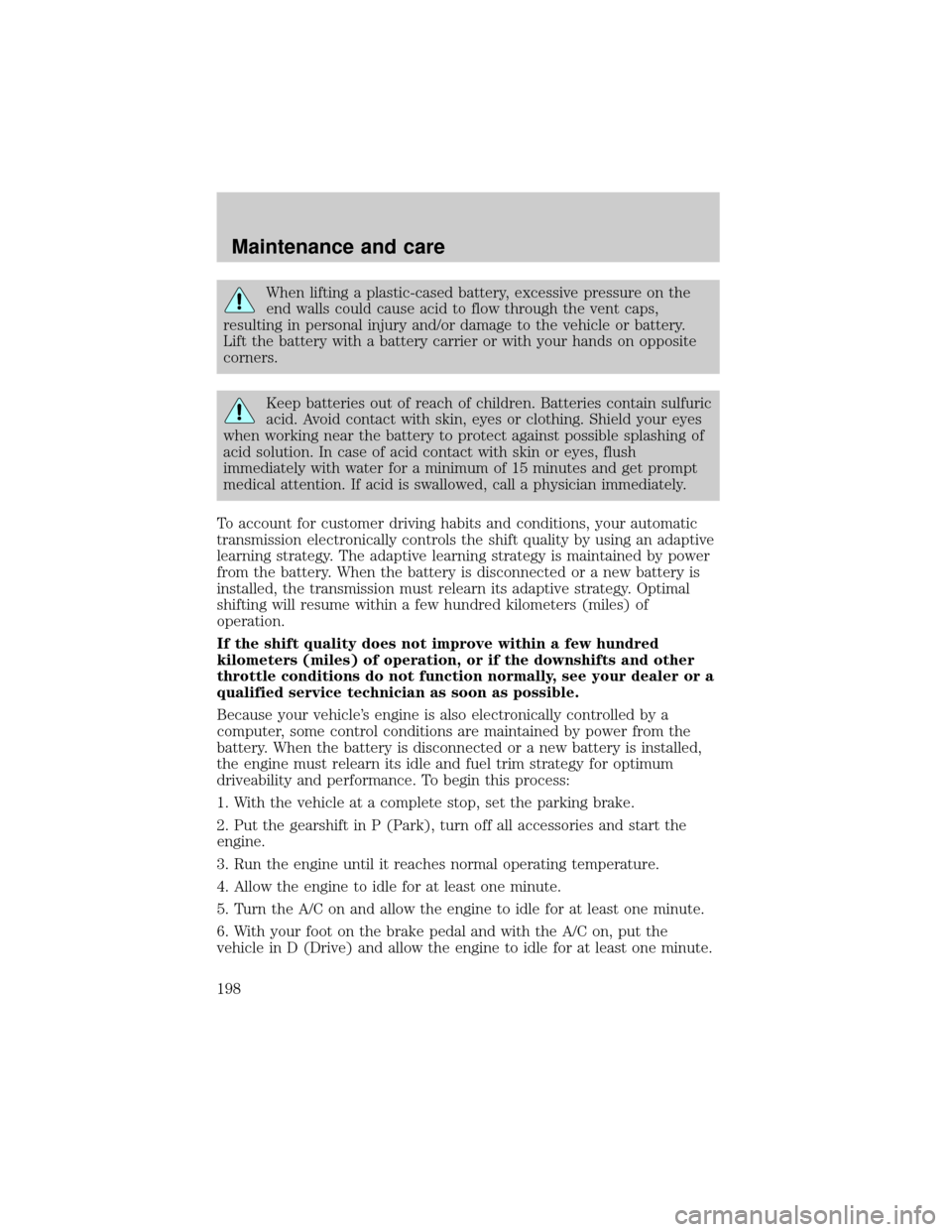
When lifting a plastic-cased battery, excessive pressure on the
end walls could cause acid to flow through the vent caps,
resulting in personal injury and/or damage to the vehicle or battery.
Lift the battery with a battery carrier or with your hands on opposite
corners.
Keep batteries out of reach of children. Batteries contain sulfuric
acid. Avoid contact with skin, eyes or clothing. Shield your eyes
when working near the battery to protect against possible splashing of
acid solution. In case of acid contact with skin or eyes, flush
immediately with water for a minimum of 15 minutes and get prompt
medical attention. If acid is swallowed, call a physician immediately.
To account for customer driving habits and conditions, your automatic
transmission electronically controls the shift quality by using an adaptive
learning strategy. The adaptive learning strategy is maintained by power
from the battery. When the battery is disconnected or a new battery is
installed, the transmission must relearn its adaptive strategy. Optimal
shifting will resume within a few hundred kilometers (miles) of
operation.
If the shift quality does not improve within a few hundred
kilometers (miles) of operation, or if the downshifts and other
throttle conditions do not function normally, see your dealer or a
qualified service technician as soon as possible.
Because your vehicle's engine is also electronically controlled by a
computer, some control conditions are maintained by power from the
battery. When the battery is disconnected or a new battery is installed,
the engine must relearn its idle and fuel trim strategy for optimum
driveability and performance. To begin this process:
1. With the vehicle at a complete stop, set the parking brake.
2. Put the gearshift in P (Park), turn off all accessories and start the
engine.
3. Run the engine until it reaches normal operating temperature.
4. Allow the engine to idle for at least one minute.
5. Turn the A/C on and allow the engine to idle for at least one minute.
6. With your foot on the brake pedal and with the A/C on, put the
vehicle in D (Drive) and allow the engine to idle for at least one minute.
Maintenance and care
198
Page 206 of 256

WHAT YOU SHOULD KNOW ABOUT AUTOMOTIVE FUELS
Important safety precautions
Do not overfill the fuel tank. The pressure in an overfilled tank
may cause leakage and lead to fuel spray and fire.
The fuel system may be under pressure. If the fuel filler cap is
venting vapor or if you hear a hissing sound, wait until it stops
before completely removing the fuel filler cap. Otherwise, fuel may
spray out and injure you or others.
If you do not use the proper fuel filler cap, excessive pressure or
vacuum in the fuel tank may damage the fuel system or cause
the fuel system to work improperly in a collision, which may result in
possible personal injury.
Automotive fuels can cause serious injury or death if misused or
mishandled.
Gasoline may contain benzene, which is a cancer-causing agent.
Observe the following guidelines when handling automotive fuel:
²Extinguish all smoking materials
and any open flames before
fueling your vehicle.
²Always turn off the vehicle before
fueling.
²Automotive fuels can be harmful
or fatal if swallowed. Fuel such as
gasoline is highly toxic and if
swallowed can cause death or
permanent injury. If fuel is
swallowed, call a physician immediately, even if no symptoms are
immediately apparent. The toxic effects of fuel may not be visible for
hours.
Maintenance and care
206
Page 210 of 256
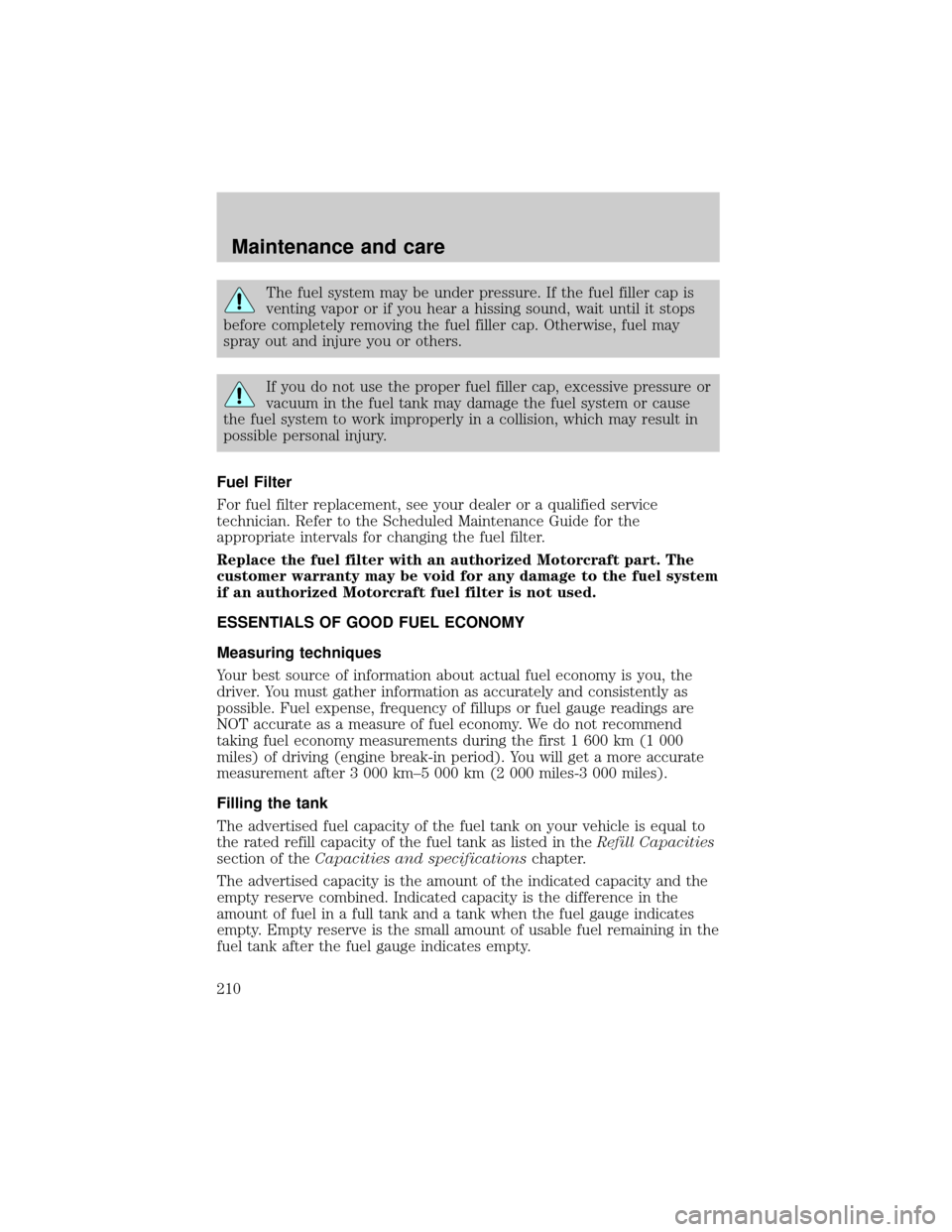
The fuel system may be under pressure. If the fuel filler cap is
venting vapor or if you hear a hissing sound, wait until it stops
before completely removing the fuel filler cap. Otherwise, fuel may
spray out and injure you or others.
If you do not use the proper fuel filler cap, excessive pressure or
vacuum in the fuel tank may damage the fuel system or cause
the fuel system to work improperly in a collision, which may result in
possible personal injury.
Fuel Filter
For fuel filter replacement, see your dealer or a qualified service
technician. Refer to the Scheduled Maintenance Guide for the
appropriate intervals for changing the fuel filter.
Replace the fuel filter with an authorized Motorcraft part. The
customer warranty may be void for any damage to the fuel system
if an authorized Motorcraft fuel filter is not used.
ESSENTIALS OF GOOD FUEL ECONOMY
Measuring techniques
Your best source of information about actual fuel economy is you, the
driver. You must gather information as accurately and consistently as
possible. Fuel expense, frequency of fillups or fuel gauge readings are
NOT accurate as a measure of fuel economy. We do not recommend
taking fuel economy measurements during the first 1 600 km (1 000
miles) of driving (engine break-in period). You will get a more accurate
measurement after 3 000 km±5 000 km (2 000 miles-3 000 miles).
Filling the tank
The advertised fuel capacity of the fuel tank on your vehicle is equal to
the rated refill capacity of the fuel tank as listed in theRefill Capacities
section of theCapacities and specificationschapter.
The advertised capacity is the amount of the indicated capacity and the
empty reserve combined. Indicated capacity is the difference in the
amount of fuel in a full tank and a tank when the fuel gauge indicates
empty. Empty reserve is the small amount of usable fuel remaining in the
fuel tank after the fuel gauge indicates empty.
Maintenance and care
210
Page 213 of 256
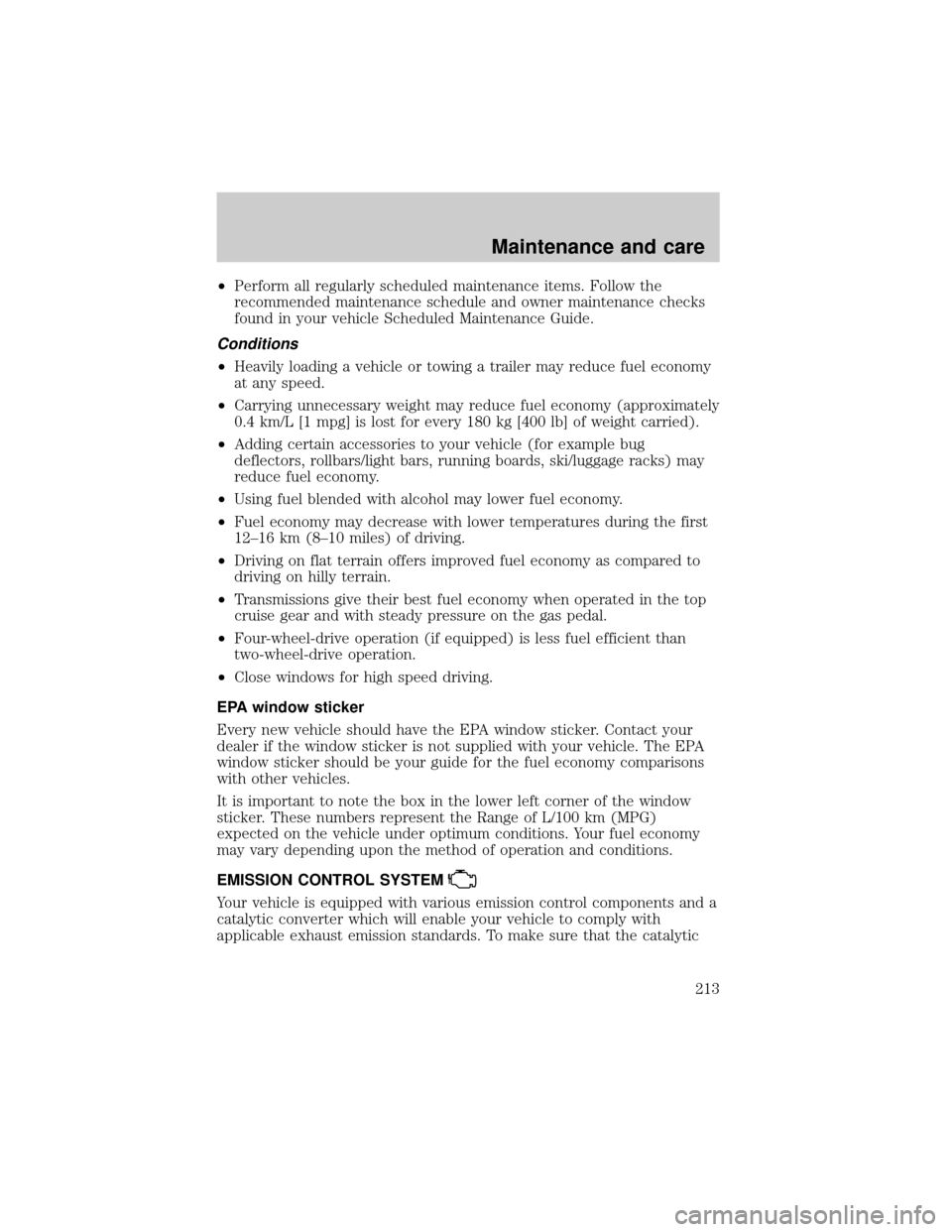
²Perform all regularly scheduled maintenance items. Follow the
recommended maintenance schedule and owner maintenance checks
found in your vehicle Scheduled Maintenance Guide.
Conditions
²Heavily loading a vehicle or towing a trailer may reduce fuel economy
at any speed.
²Carrying unnecessary weight may reduce fuel economy (approximately
0.4 km/L [1 mpg] is lost for every 180 kg [400 lb] of weight carried).
²Adding certain accessories to your vehicle (for example bug
deflectors, rollbars/light bars, running boards, ski/luggage racks) may
reduce fuel economy.
²Using fuel blended with alcohol may lower fuel economy.
²Fuel economy may decrease with lower temperatures during the first
12±16 km (8±10 miles) of driving.
²Driving on flat terrain offers improved fuel economy as compared to
driving on hilly terrain.
²Transmissions give their best fuel economy when operated in the top
cruise gear and with steady pressure on the gas pedal.
²Four-wheel-drive operation (if equipped) is less fuel efficient than
two-wheel-drive operation.
²Close windows for high speed driving.
EPA window sticker
Every new vehicle should have the EPA window sticker. Contact your
dealer if the window sticker is not supplied with your vehicle. The EPA
window sticker should be your guide for the fuel economy comparisons
with other vehicles.
It is important to note the box in the lower left corner of the window
sticker. These numbers represent the Range of L/100 km (MPG)
expected on the vehicle under optimum conditions. Your fuel economy
may vary depending upon the method of operation and conditions.
EMISSION CONTROL SYSTEM
Your vehicle is equipped with various emission control components and a
catalytic converter which will enable your vehicle to comply with
applicable exhaust emission standards. To make sure that the catalytic
Maintenance and care
213
Page 222 of 256
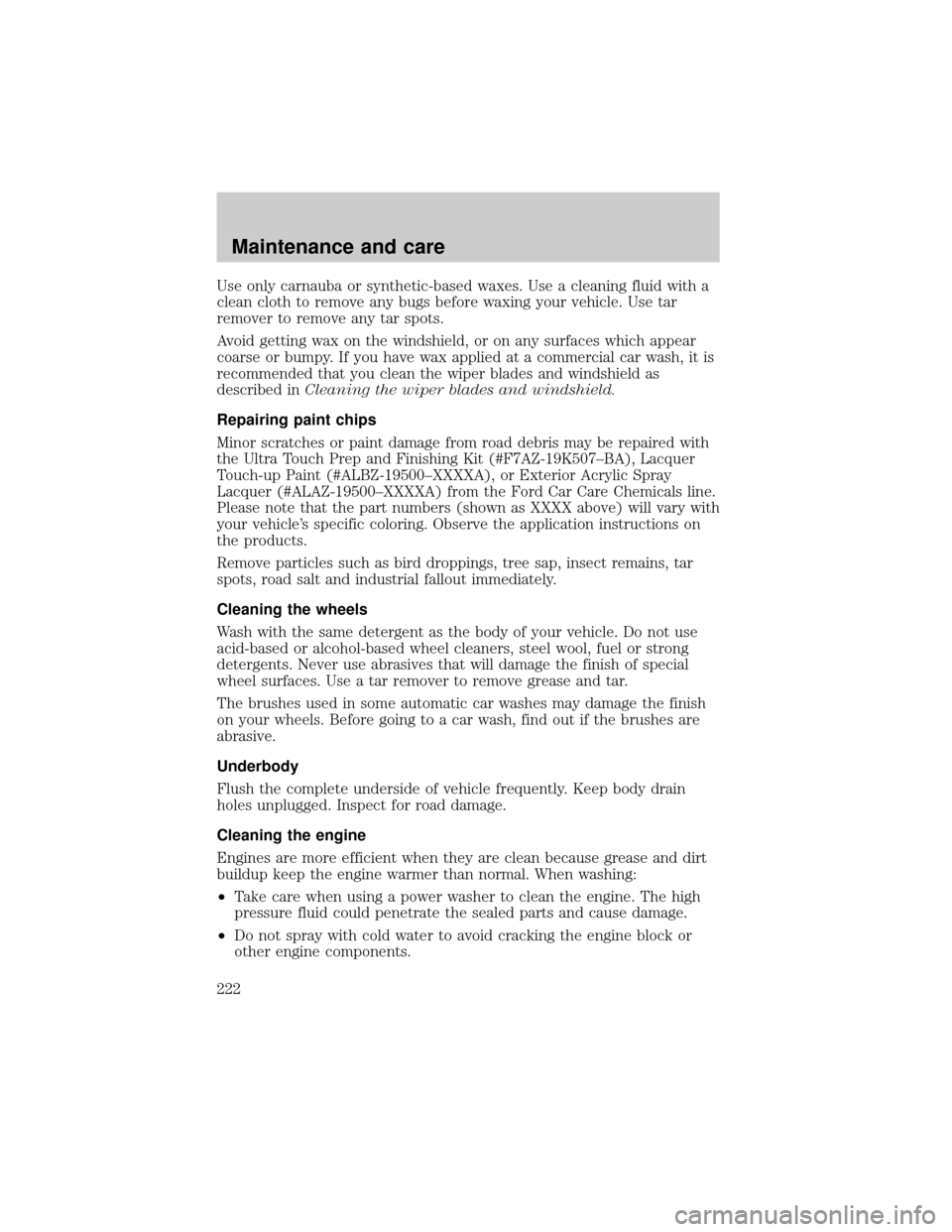
Use only carnauba or synthetic-based waxes. Use a cleaning fluid with a
clean cloth to remove any bugs before waxing your vehicle. Use tar
remover to remove any tar spots.
Avoid getting wax on the windshield, or on any surfaces which appear
coarse or bumpy. If you have wax applied at a commercial car wash, it is
recommended that you clean the wiper blades and windshield as
described inCleaning the wiper blades and windshield.
Repairing paint chips
Minor scratches or paint damage from road debris may be repaired with
the Ultra Touch Prep and Finishing Kit (#F7AZ-19K507±BA), Lacquer
Touch-up Paint (#ALBZ-19500±XXXXA), or Exterior Acrylic Spray
Lacquer (#ALAZ-19500±XXXXA) from the Ford Car Care Chemicals line.
Please note that the part numbers (shown as XXXX above) will vary with
your vehicle's specific coloring. Observe the application instructions on
the products.
Remove particles such as bird droppings, tree sap, insect remains, tar
spots, road salt and industrial fallout immediately.
Cleaning the wheels
Wash with the same detergent as the body of your vehicle. Do not use
acid-based or alcohol-based wheel cleaners, steel wool, fuel or strong
detergents. Never use abrasives that will damage the finish of special
wheel surfaces. Use a tar remover to remove grease and tar.
The brushes used in some automatic car washes may damage the finish
on your wheels. Before going to a car wash, find out if the brushes are
abrasive.
Underbody
Flush the complete underside of vehicle frequently. Keep body drain
holes unplugged. Inspect for road damage.
Cleaning the engine
Engines are more efficient when they are clean because grease and dirt
buildup keep the engine warmer than normal. When washing:
²Take care when using a power washer to clean the engine. The high
pressure fluid could penetrate the sealed parts and cause damage.
²Do not spray with cold water to avoid cracking the engine block or
other engine components.
Maintenance and care
222
Page 250 of 256

Floor mats ...................................81
Fluid capacities .........................226
Foglamps .....................................20
Four-Wheel Drive vehicles ..12,144
control trac ........................22,145
description ..............................145
driving off road .......................147
electronic shift ...................22,146
indicator light ...........................12
preparing to
drive your vehicle ...................140
Fuel ............................................206
calculating fuel economy .......210
cap ...........................................209
capacity ...................................226
choosing the right fuel ...........208
comparisons with EPA fuel
economy estimates .................213
detergent in fuel .....................209
filling your vehicle
with fuel ....................206,209,210
filter, specifications .........210,226
fuel pump shut-off switch .....160
gauge .........................................14
improving fuel economy ........210
low fuel warning light ................8
octane rating ....................208,232
quality ......................................208
running out of fuel .................209
safety information relating
to automotive fuels ................206
Fuses ...................................161,162
Garage door opener ....................70
Gas cap (see Fuel cap) ............209
Gas mileage
(see Fuel economy) .................210
Gauges .........................................14
battery voltage gauge ...............16
engine coolant
temperature gauge ...................15
engine oil pressure gauge ........16
fuel gauge ..................................14odometer ...................................15
speedometer .............................14
tachometer ................................16
trip odometer ............................15
GAWR
(Gross Axle Weight Rating) .....149
calculating ...............................151
definition .................................149
driving with a heavy load ......149
location ....................................149
GVWR (Gross
Vehicle Weight Rating) .............149
calculating ........................149,151
definition .................................149
driving with a heavy load ......149
location ....................................149
Hazard flashers .........................160
Head restraints ......................92,97
Headlamps ...................................19
aiming ......................................221
autolamp system .......................20
bulb specifications ..................219
daytime running lights .............19
flash to pass ..............................19
high beam ............................11,19
replacing bulbs .......................216
turning on and off ....................19
warning chime ..........................13
Heating ........................................51
heating and
air conditioning system ............51
Hood ..........................................182
Ignition .......................................232
positions of the ignition ...........62
Infant seats
(see Safety seats) .....................123
Inspection/maintenance
(I/M) testing ..............................215
Instrument panel
cleaning ...................................224
cluster ...................................8,224
Index
250
Page 251 of 256

lighting up
panel and interior .....................20
location of components ..............8
Jump-starting your vehicle ......175
Keyless entry system
autolock .....................................89
locking and unlocking doors ....91
programming entry code .........90
Keys
key in ignition chime ...............13
positions of the ignition ...........62
Lamps
autolamp system .......................20
bulb replacement
specifications chart ................219
cargo lamps ...............................20
daytime running light ...............19
fog lamps ...................................20
headlamps .................................19
headlamps, flash to pass ..........19
instrument panel, dimming .....20
interior lamps ...............75,76,220
replacing
bulbs ............215,216,217,218,219
Lane change indicator
(see Turn signal) ........................63
Liftgate ........................................81
Lights, warning and indicator ......8
air bag ..........................................9
air suspension .........................139
anti-lock brakes (ABS) .....10,135
anti-theft ...................................11
brake ..........................................10
charging system ........................11
check coolant ............................11
cruise indicator .........................12
door ajar ....................................12
engine oil pressure ...................11
high beam .................................11
low fuel ........................................8
low washer fluid .......................12
safety belt .................................10service engine soon ....................8
turn signal indicator .................10
Load limits .................................149
GAWR ......................................149
GVWR ......................................149
trailer towing ..........................149
Loading instructions .................151
Locks
autolock .....................................89
childproof ..................................78
doors ..........................................78
Lubricant specifications ....229,232
Lumbar support, seats ...............92
Message center ......................17,71
english/metric button ...............17
menu button .............................17
Mirrors .........................................76
automatic dimming
rearview mirror .........................76
fold away ...................................80
heated ........................................79
programmable memory ............88
side view mirrors (power) .......79
Moon roof ....................................70
Motorcraft parts .................210,226
Octane rating ............................208
Odometer .....................................15
Oil (see Engine oil) ..................183
Overdrive .....................................68
Panic alarm feature, remote
entry system ................................85
Parking brake ............................136
Parts (see Motorcraft parts) ....226
Pedals (see Power
adjustable foot pedals) ...............21
Power adjustable foot pedals .....21
Power distribution box
(see Fuses) ...............................166
Power door locks ...................78,89
Power steering ...................137,138
fluid, checking and adding ....193
fluid, refill capacity ................226
Index
251
Page 255 of 256
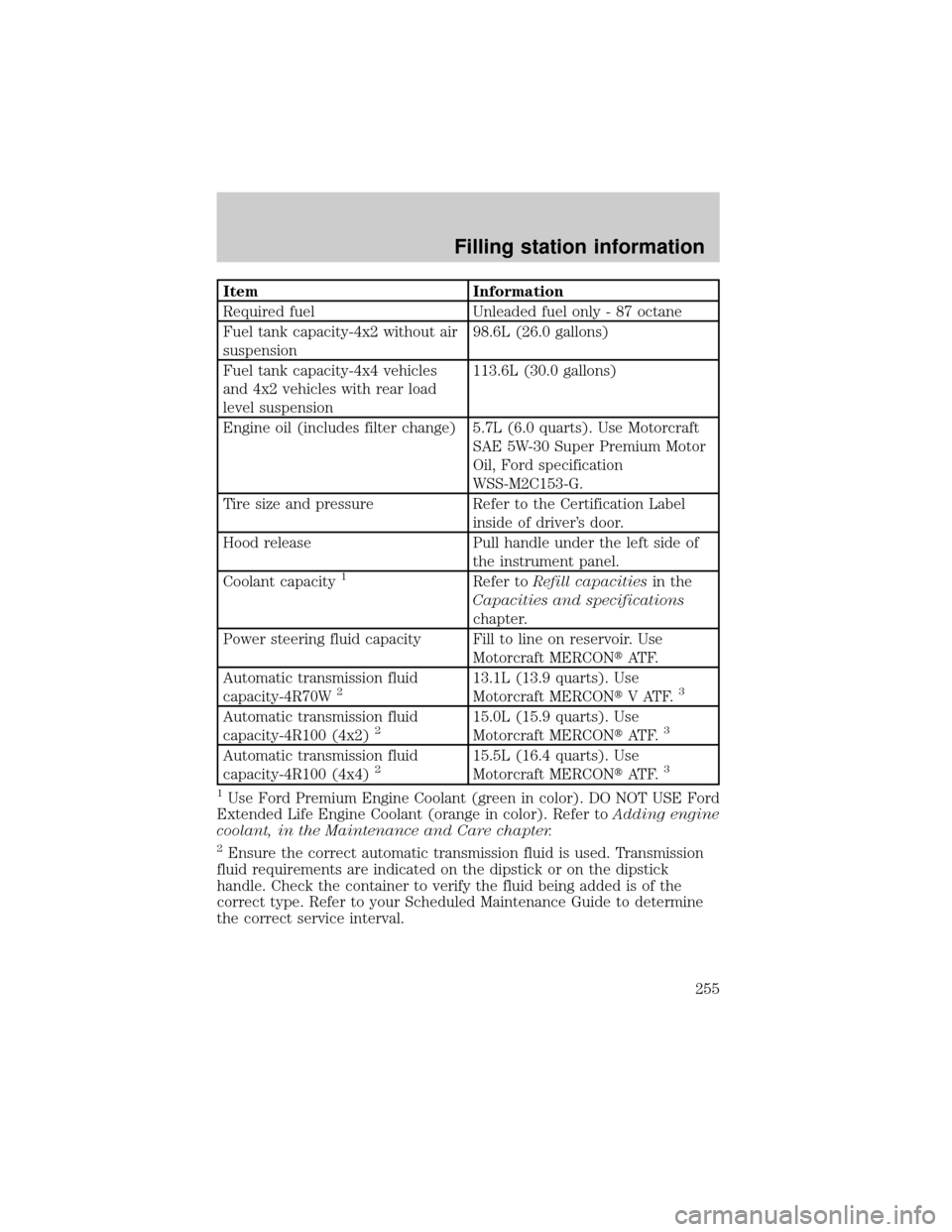
Item Information
Required fuel Unleaded fuel only - 87 octane
Fuel tank capacity-4x2 without air
suspension98.6L (26.0 gallons)
Fuel tank capacity-4x4 vehicles
and 4x2 vehicles with rear load
level suspension113.6L (30.0 gallons)
Engine oil (includes filter change) 5.7L (6.0 quarts). Use Motorcraft
SAE 5W-30 Super Premium Motor
Oil, Ford specification
WSS-M2C153-G.
Tire size and pressure Refer to the Certification Label
inside of driver's door.
Hood release Pull handle under the left side of
the instrument panel.
Coolant capacity
1Refer toRefill capacitiesin the
Capacities and specifications
chapter.
Power steering fluid capacity Fill to line on reservoir. Use
Motorcraft MERCONtAT F.
Automatic transmission fluid
capacity-4R70W
213.1L (13.9 quarts). Use
Motorcraft MERCONtV ATF.3
Automatic transmission fluid
capacity-4R100 (4x2)215.0L (15.9 quarts). Use
Motorcraft MERCONtAT F.3
Automatic transmission fluid
capacity-4R100 (4x4)215.5L (16.4 quarts). Use
Motorcraft MERCONtAT F.3
1
Use Ford Premium Engine Coolant (green in color). DO NOT USE Ford
Extended Life Engine Coolant (orange in color). Refer toAdding engine
coolant, in the Maintenance and Care chapter.
2Ensure the correct automatic transmission fluid is used. Transmission
fluid requirements are indicated on the dipstick or on the dipstick
handle. Check the container to verify the fluid being added is of the
correct type. Refer to your Scheduled Maintenance Guide to determine
the correct service interval.
Filling station information
255